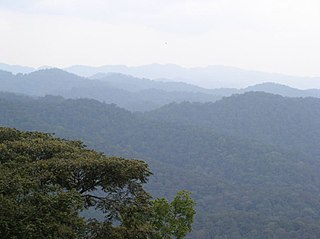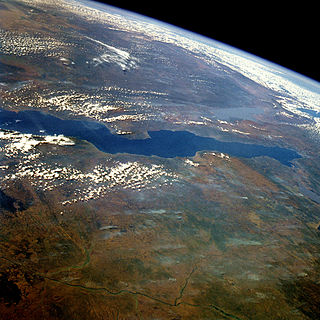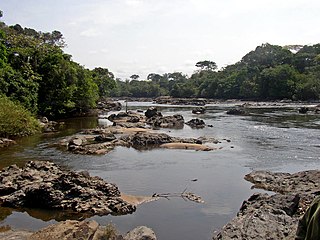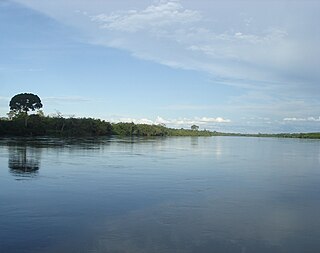 W
WThe Albertine Rift montane forests is a tropical moist broadleaf forest ecoregion in east-central Africa. The ecoregion covers the mountains of the northern Albertine Rift, and is home to distinct Afromontane forests with high biodiversity.
 W
WAngolan miombo woodlands cover most of central Angola and extend into the Democratic Republic of Congo. They are part of the larger miombo ecosystem that covers much of eastern and southern Africa.
 W
WThe Atlantic Equatorial coastal forests, also known as the Congolian coastal forests, are a tropical moist broadleaf forest ecoregion of central Africa, covering hills, plains, and mountains of the Atlantic coast of Cameroon, Equatorial Guinea, Gabon, Republic of the Congo, Angola, and Democratic Republic of the Congo.
 W
WThe Central African mangroves ecoregion consists of the largest area of mangrove swamp in Africa, located on the coasts of West Africa, mainly in Nigeria.
 W
WThe Central Congolian lowland forests are an ecoregion within the Democratic Republic of the Congo. This is a remote, inaccessible area of low-lying dense wet forest, undergrowth and swamp in the Cuvette Centrale region of the Congo Basin south of the arc of the River Congo.
 W
WThe densely forested Central Zambezian miombo woodlands that cut across southern central Africa are one of the largest ecoregions on the continent and home to a great variety of wildlife, including many large mammals.
 W
WThe Congolian rainforests are a broad belt of lowland tropical moist broadleaf forests which extend across the basin of the Congo River and its tributaries in Central Africa.
 W
WThe East Sudanian Savanna is a hot, dry, tropical savanna ecoregion of Central and East Africa.
 W
WThe Eastern Congolian swamp forests are a fairly intact but underresearched ecoregion of the tropical and subtropical moist broadleaf forests biome. It is located within the Democratic Republic of the Congo. This is the eastern half of one of the largest areas of swamps in the world.
 W
WThe Kasai River is a tributary of the Congo River, located in Central Africa. The river begins in central Angola and flows to the east until it reaches the border between Angola and the Democratic Republic of the Congo (DRC), where it turns north and serves as the border until it flows into the DRC. From Ilebo, between the confluences with Lulua river and Sankuru river, the Kasai river turns to a westerly direction. The lower stretch of the river from the confluence with Fimi river, is known as the Kwa(h) River, before it joins the Congo at Kwamouth northeast of Kinshasa. The Kasai basin consists mainly of equatorial rainforest areas, which provide an agricultural land in a region noted for its infertile, sandy soil. It is a tributary of Congo river and diamonds are found in this river. Around 60% of diamonds in Belgium go from Kasai river for cutting and shaping.
 W
WLake Tanganyika is an African Great Lake. It is the second-oldest freshwater lake in the world, the second-largest by volume, and the second-deepest, in all cases after Lake Baikal in Siberia. It is the world's longest freshwater lake. The lake is shared between four countries – Tanzania, the Democratic Republic of the Congo (DRC), Burundi, and Zambia, with Tanzania (46%) and DRC (40%) possessing the majority of the lake. It drains into the Congo River system and ultimately into the Atlantic Ocean.
 W
WLivingstone Falls — named for the explorer David Livingstone — are a succession of enormous rapids on the lower course of the Congo River in west equatorial Africa, downstream from Malebo Pool in the Democratic Republic of the Congo.
 W
WLivingstone Falls — named for the explorer David Livingstone — are a succession of enormous rapids on the lower course of the Congo River in west equatorial Africa, downstream from Malebo Pool in the Democratic Republic of the Congo.
 W
WLake Mai-Ndombe is a large freshwater lake in Mai-Ndombe province in western Democratic Republic of the Congo. The lake is within the Tumba-Ngiri-Maindombe area, the largest Wetland of International Importance recognized by the Ramsar Convention in the world.
 W
WThe Pool Malebo, formerly Stanley Pool, also known as Lake Nkunda by local indigenous people in pre-colonial times, is a lake-like widening in the lower reaches of the Congo River. The river serves as the border between the Republic of the Congo on the north and the Democratic Republic of the Congo to the south.
 W
WThe Miombo woodland is a tropical and subtropical grasslands, savannas, and shrublands biome. It includes four woodland savanna ecoregions characterized by the dominant presence of Brachystegia and Julbernardia species of trees, and has a range of climates ranging from humid to semi-arid, and tropical to subtropical or even temperate. The trees characteristically shed their leaves for a short period in the dry season to reduce water loss, and produce a flush of new leaves just before the onset of the rainy season with rich gold and red colours masking the underlying chlorophyll, reminiscent of temperate autumn colours in the temperate zone.
 W
WThe Northeastern Congolian lowland forests is a tropical moist broadleaf forest ecoregion that spans the Democratic Republic of the Congo and the Central African Republic.
 W
WThe Northern Congolian forest-savanna mosaic is a forest and savanna ecoregion of central Africa, part of the belt of transitional forest-savanna mosaic that lie between Africa's equatorial forests and the tropical dry forests, savannas, and grasslands that lie to the north and south.
 W
WThe Ruwenzori-Virunga montane moorlands is a montane grasslands and shrublands ecoregion of central Africa.
 W
WThe Sangha River, a tributary of the Congo River, is located in Central Africa.
 W
WThe southern Congolian forest-savanna mosaic is an ecoregion that covers a large area of the southern Democratic Republic of the Congo and northeastern Angola. Its rich blend of habitats provides key insights into the biogeography of central Africa with the extensive climatic variation that it has been experiencing for the last 10 million years. The human population is not high.
 W
WLake Tumba is a shallow lake in northwestern part of the Democratic Republic of the Congo, in the Bikoro Territory of the Province of Équateur.
 W
WThe Uele, also known by the phonetically identical Uélé, Ouélé, or Welle River, is a river in the Democratic Republic of the Congo. The Uele forms at Dungu, at the confluence of the Dungu and Kibali rivers, which both originate in the mountains near Lake Albert. Combined these rivers flows west for about 1,210 kilometres (750 mi), until the Uele joins the Mbomou River at Yakoma.
 W
WLivingstone Falls — named for the explorer David Livingstone — are a succession of enormous rapids on the lower course of the Congo River in west equatorial Africa, downstream from Malebo Pool in the Democratic Republic of the Congo.
 W
WThe Victoria Basin forest-grassland mosaic is an ecoregion that lies mostly in Uganda and extends into neighboring countries. The ecoregion is centered north and west of Lake Victoria, with an outlier on the border of Ethiopia and South Sudan.
 W
WThe Western Congolian forest-savanna mosaic is an ecoregion of Angola, Democratic Republic of the Congo, Republic of the Congo, and Gabon.
 W
WThe Western Congolian swamp forests are an ecoregion of the Republic of the Congo and Democratic Republic of the Congo. Together with the adjacent Eastern Congolian swamp forests, it forms one of the largest continuous areas of freshwater swamp forest in the world. It is a flooded forest with a high canopy, dense undergrowth and has a muddy floor. It has not been disturbed very much by outside influences and so remains largely pristine as getting through this forest is called "almost impossible".
 W
WThe Zambezian flooded grasslands is an ecoregion of southern and eastern Africa that is rich in wildlife.